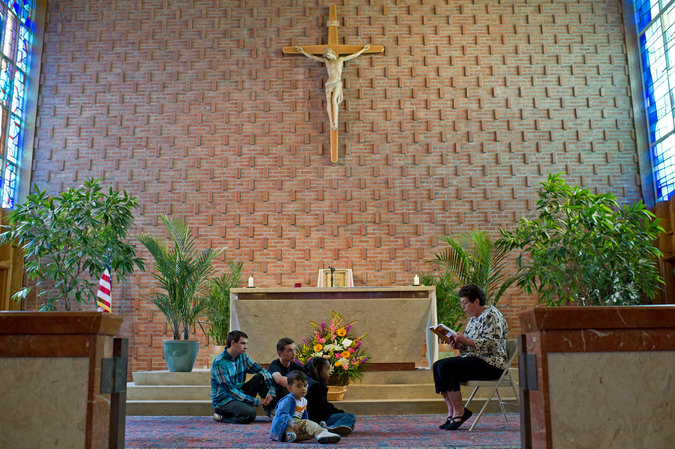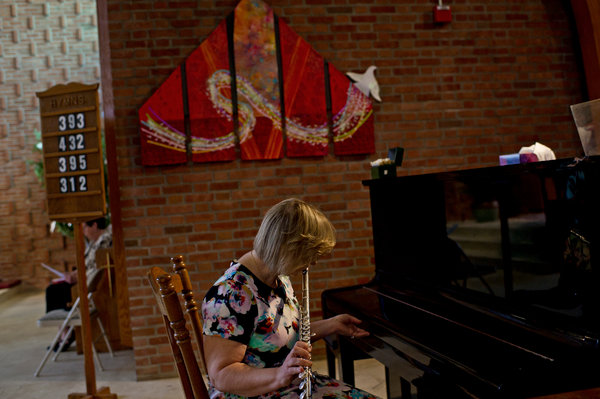Catholics Defy Boston Archdiocese with 11-year Vigil to Keep Church
By Jess Bidgood
It was a bright Sunday morning at St. Frances Xavier Cabrini Church, and the building’s stained glass windows cast a jewel-colored glow over the service. An elegant 81-year-old woman led a few dozen congregants in Catholic prayer. A single flutist accompanied the hymns. But there was no priest. The parishioners were not, in fact, supposed to be there. And there is nothing the Archdiocese of Boston would like more than for them to get out. “We,” Jon Rogers, one of the organizers, said with some frustration, “are disobedient Catholics.” The parishioners here gather every Sunday for acts of communion and epic resistance. The building is deconsecrated. The parish was, like dozens of others in the region, slated to close in 2004, but some of its members, who call themselves Friends of St. Frances X. Cabrini, have kept it open by keeping at least one member inside the church at all times — a dogged effort called a vigil. Continue reading the main story RELATED COVERAGE Ronalde Marie on Sunday at Our Lady of Peace on the Upper East Side, which is scheduled to merge with another parish.‘Mass Mob’ Fills a Manhattan Church With Hopes of Saving ItJAN. 25, 2015 Noon Mass on Friday at St. John the Martyr on the Upper East Side.New York Archdiocese Will Close 7 More ChurchesMAY 8, 2015 Wielding baked goods, detailed sign-up sheets and fierce devotion, they have frustrated the powerful Archdiocese of Boston, of which they are a part, and officials there have taken their own parishioners to court to get them out. In the coming months, the two parties will meet again in court for the parishioners’ appeal. The petitioners filed their brief in a Massachusetts appeals court this week. The unusual effort has drawn attention from church historians, who say it is among the longest — if not the longest — vigils of its kind, coming decades after the Vatican broadened the role of laypeople in the church. They are now on their third pope since the vigil started; even the Vatican has been unable to dissuade them. The parishioners, historians say, have looked to writings of the Second Vatican Council, in the 1960s, on expanding the role of laypeople in the church. “The remarkable thing is the fact of people doing it at all,” said James O’Toole, a professor who specializes in American Catholic history at Boston College. He added, “Fifty years ago, I don’t think parishioners would have thought that that was within the realm of the possible.” St. Frances X. Cabrini opened in this seaside suburb in 1961 in the Archdiocese of Boston, where Catholicism had thrived for generations, especially among immigrant populations. But by the mid-2000s, said Professor O’Toole, the church had “too much infrastructure, and not enough resources to be able to sustain it.” Citing declining attendance, aging priests and mounting maintenance costs, the archbishop then, Sean P. O’Malley, who is now a cardinal, moved to close dozens of churches and merge their congregations with other parishes. “The church’s faith can be as alive in one place as it is in another,” Archbishop O’Malley wrote at the time. “As one church is closed, another church is waiting to welcome its people.” A handful of parishes on the list — in East Boston, Framingham, Wellesley and other cities in addition to Scituate — decided they were not going anywhere, and began vigils as a form of organized activism, said John C. Seitz, an assistant professor at Fordham University who has studied the parishes. The archdiocese was also reeling from the sexual abuse crisis, which drew wide attention here in 2002. Although officials say those revelations were not related to the closings, it was difficult for parishioners to separate the two issues. “In the wake of the abuse crisis, with the Catholic population already feeling alienated and feeling unable to trust their leaders, it kind of was the perfect storm of issues for this kind of mobilization,” Dr. Seitz said. In Scituate, about 30 miles south of Boston, it began unexpectedly. With days to go before the church was to close that October, a church door was found unlocked, and parishioners decided to take turns staying in the church, day in and day out, to ensure they could not be locked out again. “We were a vibrant, flourishing parish,” said Maryellen Rogers, another organizer of the vigil, who is married to Mr. Rogers. “We’re meant to be here.” Nearly 11 years later, Scituate’s vigil is the only one still going. The vast parking lot sits mostly empty, and the roof of the church has lost some tiles. But a white sign next to its open door urges people to come inside. Parishioners choose their vigil shifts on expansive sign-up sheets — the Rogerses say about 100 people are involved in the effort — and take turns sleeping on lumpy mattresses, passing daytime shifts with prayer, puzzles and laps around the sanctuary for exercise, walking past bright quilts that mark each year of the vigil. It has created a never-ending church group that has actually drawn new members, like Karen Virginia, 49, to the church. And she pointed out that, with no priest, the parishioners lead services. “When you feel part of what’s going on at the altar,” Ms. Virginia said, “it makes it a stronger place.” On Friday nights, vigil duty falls to 16-year-old triplets, who arrive around 9 p.m., sometimes with friends or a pizza, to sleep or watch television online.
“We’re going to be here forever,” said Christian Arnold, one of the triplets. Except that is not the archdiocese’s plan. The parishioners last year lost their appeal to the Vatican’s highest court, the Apostolic Signatura. But they say the Vatican’s Pontifical Council for the Interpretation of Legislative Texts is still looking over their case. Officials at the Archdiocese of Boston this year asked them to vacate the church, and filed the lawsuit when they did not, saying the parishioners were trespassing. The parishioners have argued that they, not the archdiocese, own the church, and that civil courts do not have standing to decide an “ecclesiastical dispute.” In May, Justice Edward P. Leibensperger of Superior Court ruled in favor of the archdiocese. “The defendants, and those individuals in active concert with them, are unlawfully and intentionally committing a trespass by the continuation of their protest vigil on the premises of the church,” Justice Leibensperger wrote. He ordered them out. “We ask the Friends of St. Frances to respect that decision and conclude the vigil,” the archdiocese said in a terse statement. A spokesman for the archdiocese, Terrence Donilon, has declined further comment on the case. But, for now, the parishioners have no intention of complying. They won a stay on the order to vacate, pending their appeal, and so the vigil endures. “The truth of the matter is that the parishioners of St. Frances are the true owners of this church,” said Mr. Rogers, one of the organizers. He added, “If the archdiocese wins this case, it’s going to set precedents for all the people who attend these beautiful churches that they build. They will become hourly renters in their own houses of worship.”
|
.
Any original material on these pages is copyright © BishopAccountability.org 2004. Reproduce freely with attribution.

